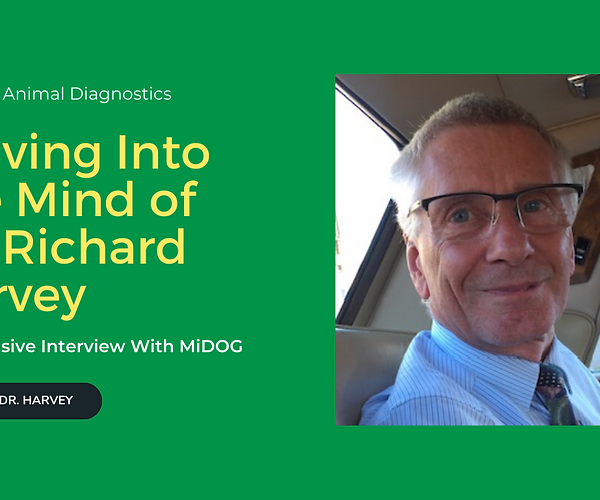
Dr. Richard Harvey, BVSc DVD DipECVD PhD FRSB FRCVS, European Specialist in Veterinary Dermatology, Head of Dermatology
This is part 2 of our exclusive interview with Dr. Richard Harvey. The first part covered Next-Generation Sequencing in Veterinary Medicine which can be found here.
Part 2 will be covering questions for Dr. Harvey that are a little more personal and career-oriented for us and our audience to get to know him a little bit better and shed light on his background, interests, and veterinary journey experience.
A Look Into Dr. Harvey’s Veterinary Journey

To start off, could you share with us your journey and passion for becoming a veterinarian, particularly in the field of dermatology, and what motivated you to specialize in this area?
I can tell you the wake-up moment. I was working mixed practice in Lincolnshire and the veterinary practice used duphar horse vaccination. It was a horse practice and as a thank you for buying duphar vaccine, you could choose a textbook and for some reason he chose…
“Moore and Kirk’s Dermatology, 3rd edition, the blue one. I was just knocked out and that was my wake-up moment. That was about 1977.”
Throughout your career, you have achieved several milestones, including obtaining the UK and European Diplomas in Veterinary Dermatology and a PhD. How did these accomplishments shape your professional trajectory?
Not quite as much as you would have imagined initially in that I had my own practice. So, within the practice, I gave diploma-level dermatology. I was on the European board, we went to the European meetings, and my children went all around Europe with us going to the European dermatology meetings.
So yeah, I hit dermatology at a good time, and I had a productive career at it and now at the end of my career, I’m doing full-time dermatology again. It’s perfect!
Since your focus is on small animals, what aspects of working with dogs and cats do you find most rewarding and challenging?
It’s warm and dry. I’ve done my fill of testing cows on a frozen winter morning, so it’s warm and dry.
“One of the advantages of having your own practices is that you see three generations of allergic dogs over the years. So, you get to know the clients as individuals.”
That’s not to say farm vets don’t know their farmer clients as individuals, but you get to know the animals of individuals. Obviously, in high-end horse practice, you might know the horses as individuals, but in many cases, you perhaps wouldn’t know them that much in the standard horse practice. So, it gives you the opportunity to do that.
Since we know that you’ve published 29 scientific papers and coauthored textbooks on ear disease and ear nose and throat disease, what inspired you to contribute to academia and share your knowledge with the veterinary community?
“I enjoy doing it!”
Enjoy writing and researching.
In your experience, what are some of the most common misconceptions or misunderstandings pet owners have about dermatological issues in their animals?
Frustration that they don’t understand what’s happening when they can see it right in front of them. The dog’s scratching. He’s losing hair. His ear is smelling. Perhaps frustration that they can’t get an answer quickly sometimes.
In some cases, if your dog is, well, for example, there’s a disease called VKH, which is a devastating disease that affects the eye and the skin, and paint this: If your dog is going blind, you’ll present it within two weeks. That’s the average time for VKH with an eye disease to be presented. If I see a dog with a chronic ear, oftentimes it’s three to six months down the road.
So, I think there’s a frustration amongst some owners that they’re not getting the answer they want and there’s a frustration among some vets.
“The problem isn’t getting better as quickly as they ought or it’s coming back and they don’t understand, because that’s what we’re there for. We take on these second-opinion cases and try and sort them out.”
As a specialist in veterinary dermatology, you must have encountered some fascinating and challenging cases. Can you share one or two memorable cases that left a significant impact on your career and approach to treatment?
I don’t think anything’s had a huge impact on my career. Well, I did get a veterinary prize for producing a paper from practice. It was the prize for the best paper from practice. So that was a nice reward. Somebody recognized me. Everything else, like publications and PhD, you earn, you work at it. So that was a nice surprise.
Besides your professional achievements, do you have any memorable moments with animals that have had a lasting impression on you personally?
I can remember the headline in a local paper: “Vet cures cat with dog medicine”, which was not exactly what happened. So that was a surprise. I was in a supermarket 3 weeks ago and somebody said “Richard! Richard!” I looked around and there nobody was. One of the staff recognized me, ran across the hall, gave me a hug, and said, “Thank you for looking after my cats!” because she thought I’d retired and moved on, you see. So, she didn’t realize I was still working down the road, just doing dermatology, but that’s the sort of thing that’s nice.
Apart from your work and research, what other interests or hobbies do you have, and how do you find a balance between your professional commitments and personal life?
I cook. I read thrillers.
As a well-known figure in the veterinary community, what advice would you give to aspiring veterinarians who wish to specialize in dermatology or pursue a career in academia and research like you?
Well, there are 17 veterinary dermatologists in the UK and there are less than 25 veterinary residents in Europe. Last year, around 120 set the European Critical Care Diploma and 6 set the dermatology one. So, what’s not fun about dermatology? There are no nights, there’s no weekends. You don’t get emergencies. But maybe that’s what some people like. It’s something I like!
Throughout your career, you’ve likely encountered advancements and changes in veterinary practices and technology. How do you stay up to date with the latest developments and how do you see the future of veterinary dermatology evolving?
Well, I keep up to date by researching books. For example, I’m doing an ENT book and I’m bringing that out to date, and that can be surprising, have what you’ve missed in the last 10 years if it’s not in your specialty. I read new scientists, so I try and keep up to date with what’s happening around the world in other spheres and then I read dermatology papers. In terms of where I read most Veterinary Dermatology, I suppose, the trade journal.
Veterinary work can be emotionally demanding. How do you cope with the challenges and maintain your passion for helping animals and their owners?
“You have to be professional, considerate, compassionate, and empathic as well.”
It’s one of those things you just get on with doing. It’s part of your profession, of your life. You have to do it.
Doesn’t happen too much in dermatology. Well, there are a couple of very nasty skin cancers that look like bacterial skin infections to start with and it’s only when they come to us that they realize that it’s life-threatening. So, there are one or two instances, but most of the time it’s dealing with the frustration. And I think the other thing is giving the owners a plan. You know, they come to get a diagnosis and they get a prognosis, and they get a plan and that’s what they don’t have. And to a certain extent, I mean I was guilty of this.
“When you’re in a practice, even in a small three-man practice, it’s hard to get continuity.”
When you have a larger practice, the first person says this is XYZ and everyone else assumes it’s the same thing.
“And then the misdiagnosis is carried on for months and months and months.”
Situations where I’m in control and my companion, the two of us, talk to each other. We understand what’s going on and we try not to get in that situation where we don’t know what’s happening; Giving owners a plan is only half of the step four.
“Once you know what’s going on, that’s half the battle.”
You then understand why the dog’s getting reparented ear disease because he’s got an underlying allergy. That’s why he’s getting ear disease. It won’t go away. But they need to know that because up till then no one has said why it keeps coming back. They don’t know. Give them the answer. That’s what they need.
Your textbook on ear, nose, and throat disease is a very valuable resource in the field. What motivated you to create this textbook and what impact do you hope it will have on fellow veterinarians and students?
Well, I suppose the first answer is, we’re doing the 2nd edition. So, enough people were persuaded that the first one was good to want us to come back and do it again. So, we’re doing the 2nd edition bigger and better. And I guess that’s it. I like to keep my brain occupied. If I’m not writing papers, I’m writing a book.
The Legacy Left Behind
Finally, we asked Dr. Harvey what he envisions as his legacy in the field of veterinary dermatology and how he hopes to be remembered by his colleagues and the broader community. In which he responds,
“I’d like to be remembered as someone who’s made a difference.”
He continued to share with us how he has been working towards this legacy and his efforts towards leaving a mark in the veterinary dermatology world.
“Publishing scientific papers gives you that. You HAVE made a difference. Writing the book means that you can put it together on another level. You can communicate with clinicians rather than just your peers.”
Find Dr. Richard Harvey’s two latest publications here:
- Quantifying the mycobiome and its major constituents on the skin of 20 normal dogs
- Quantification of the bacterial flora and its major constituents on the abdominal skin of clinically healthy dogs
Categories: Next-Gen DNA Sequencing Technology, Veterinary Dermatology

